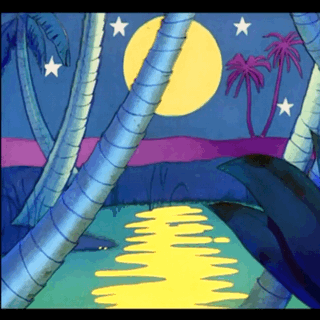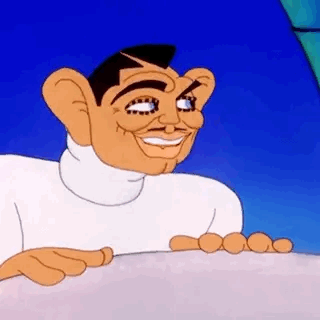Release date: November 28th, 1936
Series: Merrie Melodies
Director: Friz Freleng
Starring: Peter Lind Hayes (Walter Winchell), Berneice Hansell, Shirley Reed (Dionne Quintuplets), Tedd Pierce (W.C. Squeals), Martha Wentworth (Mae West), Jeane Cowan (Helen Morgan), Melvin Gibby (Horse Noises)
The cartoon that caused Katherine Hepburn to watch it 4 times and Clark Gable twice. An amalgamation of celebrity caricatures, designs courtesy of the great T. Hee. See Laurel and Hardy share a drink, Clark Gable flap his ears to the beat of Edna May Oliver’s dancing, W.C. Fields flirt with Katherine Hepburn, and so on.
A parody of the famed Hollywood nightclub the cocoanut grove, we open to a beautiful overlayed pan of the Coo-Coo Nut Grove, a nightclub literally nestled in a cluster of coconut trees. The backgrounds are wonderfully stylistic and sharp—not quite Art Deco, but the same “newness” that Page Miss Glory exuded so well. A zoom in reveals that the red blinking neon light advertising the nightclub is lit up by fireflies, an oldie but goodie.
Arriving to the nightclub itself, we iris in on Ben Birdie, a caricature of radio personality Ben Bernie. While he’s giving his trademark catchphrases such as “Yowza!”, a mouse caricature of journalist Walter Winchell pops out of a tuba, holding out a scallion for Birdie. “Flash! An orchid for you, old mousetrap, from your old pal Walter Windpipe!”
Birdie takes care of the pest by blowing into the mouthpiece of the tuba, propelling windpipe across the nightclub. Bernie and Winchell had a good relationship off the set, but assumed the rules of enemies on Bernie’s show. While Birdie comments that it’s an ill wind, an ill wind, yowza, we get a good look of the patrons in the crowd.
Comedian Hugh Hubert is the first celebrity, who giggles and claps, bashfully averting his gaze. As a Daffy Duck aficionado, I owe a lot to Hubert—he’s the one they based Daffy’s trademark laugh after. Thanks, Hugh! The table next to him features W.C. Squeals and Katherine “Heartburn” (an obvious play on Hepburn.) Squeals admires what a beautiful hand she has, prompting her to repeat the Boulevardier from the Bronx cackle bashfully before glaring at him in disgust. The laugh is more fitting as a horse, for sure! Hepburn would be subject to MANY, MANY references in Looney Tunes shorts, primarily by Tex Avery. Every time you hear a woman say something like “really it is,” that’s a Hepburn impression.
Next table over features a crotchety Ned Sparks, groveling “I go everywhere, I do everything, and I never have any fun.” Sparks’ shtick was always playing a miserable, deadpan character. Pan up to the coconut treetops (these backgrounds are absolutely gorgeous), where Johnny Weissmuller is pouring his wife and Vedette Lupe Vélez a glass of wine. I love the bow tie tacked on to his Tarzan garb, wonderfully tacky. Instead of offering the glass, Weissmuller downs it all in one go, beating his chest and doing the Tarzan yell that Buddy did in Buddy of the Apes. How I don’t miss you! I’m sure it’s implied, but Weissmuller was the original Tarzan. Even more interesting, he was a gold medal olympic swimmer back in the ‘20s.
Ben Birdie introduces “the profile of profiling”, and thus sparks this lovely gag of John Barrymore walking through the nightclub, his head at profile. No matter which way his body turns, his head is always at profile. Eventually, his head is turned 180 degrees backwards as he sits down at a table. If you look him up, you’ll find that many of his headshots are profiles. The same gag would be reused in Freleng’s Dog Daze and A Star is Hatched.
Elsewhere, we spot a panicked woman running from some unknown threat. Her face is concealed, so we’re unaware as to what caricature she is, but we DO know her pursuer: a bird caricature of Harpo Marx, galloping behind her and honking a horn. His hat opens to reveal an extending stop sign, and Harpo pretends to pull the brakes. The sign switches to go, and Harpo shifts back into gear, resuming his galloping routine. The animation is flighty, loose, hilarious, and ridiculous.
Back to Ben Birdie, who moves things along. “And now, let us indulge to a bit of the light fantastic, etcetera, etcetera.” Almost immediately, a crowd of couples get up to dance. It seems to me that the animation was reused from another freleng cartoon, I’m a Big Shot Now. Cut to another couple in particular, a turtle George Arliss and bird Mae West. A great pair, seeing as Mae Wear was essentially a sex symbol, and George Arliss was much older, being 68 as of 1936. Very smooth and fun animation, topped off with West affirming “Keeup up the good work.”
Another WB favorite to caricature—Laurel and Hardy. If my memory serves me correctly, this is the first time we see Hardy caricatured as a pig. In many a cartoon, he’d be portrayed as such, often mimicked by Porky. These include (but are not limited to) The Case of the Stuttering Pig, You Ought to Be in Pictures, and The Timid Toreador. Hardy grabs a coconut and signals for Laurel to share. They both put their straws in the coconut and drink, and essentially swap themselves. Hardy substantially loses weight and turns into Laurel, whereas Laurel gains substantial weight and turns into Hardy. Very clever.
The next act features Edna May Oliver, who does an elaborate dance routine to “The Lady in Red”. Clark Gable in the audience is particularly entranced, flapping his ears to the music (another Gable caricature staple.) Leon Schlesinger himself said after the cartoon’s release, “Gable [came to see the film] at least twice, mesmerized by the rhythmic waving of his own ears. That ought to answer any questions about can Hollywood stars take it.” Schlesinger kept close tabs on who came to see his films, which only makes sense: he worked at Chicago’s Colonial Theater in 1908, keeping an autograph book of all the stars who would happen to visit.
During Oliver’s dance number, a lanky, rubber hose limbed Gary Cooper struts through the nightclub, doing his walk that he would feature in many of his cartoons. A trio of monkeys observe from the treetops, one of them declaring “He’s pixilated!”
Next dance number is none other than the Dionne quintuplets, voiced by (who else?) Berneice Hansel, singing a medley of “Our Old Man” and “What’s the Matter with Father”. Hansell’s voice talents are lovely and hilarious as always, and there’s a great little dance interlude as the quints turn around and tap their feet with their butts in the air. Just in case you forgot they were babies! By this time, the quintuplets, only 2 years old, already had a movie made about them in early 1936 called The Country Doctor.
Back to Johnny Weissmuller and Lupe Vélez, who are applauding the act from the treetops. A great scene as Weissmuller spots a mouse skittering right by their table and shrieks. The great, mighty Tarzan faints at the sight, and Vélez instead does her own Tarzan cry, grabbing her cowardly husband and swinging across a vine as the mouse skitters under the table.
Back to the mysterious running woman pursued by Harpo Marx. Harpo tackles her, and the woman finally reveals herself to be none other than Groucho Marx! This gag would be much more notably reused in Tex Avery’s Hollywood Steps Out, with Clark Gable pursuing Groucho instead of harpo. I like the inclusion of Harpo, it makes the reveal all the more disturbing. Harpo, appalled, dashes out of the nightclub while Groucho grins.
The next scene is a more somber mood. Teardrops rain on the grass, and a slow pan reveals a tearful Helen Morgan singing “The Little Things You Used to Do”, perched on a piano and wringing a handkerchief. The animation is quite good, with lots subtle head tilts. Wallace Beery is particularly moved by the music. So moved, in fact, that he grabs a nearby banana hanging from a bunch, squirts out a line on a butter knife like a line of toothpaste, and shoves the knife in his mouth to cope with his heart strings being pulled. Harpo Marx is also moved, using a windshield wiper from his multipurpose hat to wipe away his tears. Edward G. Robinson and George Raft aren’t particularly moved, chuffing on a cigar and flipping a coin respectively. That is, until, they both break down in sobs and embrace each other—a great mood change and great way to totally shatter the “tough guy” act.
Now, the nightclub is totally afloat, caricatures sitting on their tables as the ground is submerged in tears. Slowly, the tables begin to drift away in the current, with the George Arliss turtle rowing along, using his shell as a boat. And with that, Ben Birdie signs off.
While this cartoon is dated, sure, I think it’s a cartoon you can enjoy, regardless if you understand the references or not. I certainly didn’t know a good 35% of the caricatures, and had to look them up. But I truly believe that’s part of the fun of it though, and that’s why I love these caricature-centric shorts. You get to explore and really get hands on, you get to research, you get to learn something new. I sure didn’t know that George Arliss was born in 1868, and I find that fascinating! I didn’t know that Ben Bernie and Walter Winchell played enemies on Bernie’s show, but now I do. It’s fascinating!
And that’s in part why I love doing these reviews. No matter what, there is always something new to learn. And besides, if anything, you can laugh and admire how the caricatures are drawn, and the backgrounds are just superb. This is definitely a visual centric cartoon, and it constitutes a watch for that alone. I prefer Hollywood Steps Out myself, but this is a good entry, especially for 1936. I say go for it!
Link!














No comments:
Post a Comment